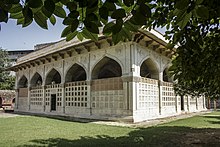Chausath Khamba
| Chausath Khamba | |
|---|---|
 View of Chausath Khamba | |
| Religion | |
| Affiliation | Islam |
| District | New Delhi |
| Province | Delhi |
| Ecclesiastical or organizational status | Tomb |
| Leadership | Jahangir |
| Year consecrated | 1624 |
| Location | |
| Location | |
| Territory | Delhi |
| Geographic coordinates | 28°35′28.7″N 77°14′30.5″E / 28.591306°N 77.241806°E |
| Architecture | |
| Architect(s) | Koka Khan-i-Azam |
| Type | Tomb |
| Style | Mughal architecture |
| Completed | 1623 |
| Specifications | |
| Direction of façade | Open on four sides |
| Dome(s) | 25 |
| Materials | Marble |
Chausath Khamba, also spelled Chaunsath Khamba, is a tomb built during 1623–24. It is located in Nizamuddin precincts of Sufi Muslim shrines and tombs in New Delhi, India. The name means "64 pillars" in Urdu and Hindi. It was built by Mirza Aziz Koka, son of Ataga Khan, as a mausoleum for himself, at the time when Mughal Emperor Jahangir ruled from Delhi. Mirza Aziz Koka had served several times as Jahangir’s Governor of Gujarat before he died in Gujarat.[1][2][3]
Structure
Chausath Khamba monument was initially built as a hall in an innovative eclectic architectural style of the Mughal period. It was later converted into a tomb. It is a square structure constructed entirely of white marble. The structure (pictured with facades) has 64 columns that support twenty five bays. Each bay supports a dome. The domes are not visible externally since they are reverse domes (picture). The roof is flat. Each wall has five arches that are held by square pilasters. In each face, between each of five pilasters, marble trellised screens have been fixed.[2][4]

According to inscriptions, the structure houses the tomb of Mirza Aziz Koka (also named Kotaltash). The tomb of his father, Ataga Khan, the Prime Minister of Akbar, is also in the vicinity. In addition, there are several other unidentified tombs inside this monument.[1][5] It is considered the family shrine of Atgah Khan.[6] The structure is enclosed and has an imposing entrance gate. The Ghalib tomb is located adjoining this structure on the northern side.[3] Comparison is drawn to a similar tomb built in marble in Sarkhej in Gujarat where Mirza Aziz Koka served several times as Jahangir’s Governor of Gujarat. He died in Sarkhej and was temporarily buried there. His remains were later shifted to Chausath Khamba.[2]
Heritage status

The Chausath Khamba is located in the busy 14th century market area of Nizamuddin Basti in New Delhi. The shrine of the Sufi saint Nizamuddin Auliya (1236 AD – 1325 AD) is nearby.[7] The monument is part of the Nizamuddin religious complex and has been declared a heritage building.[8] The forecourt of Chaunsath Khamba was recently landscaped by the Aga Khan Trust. The successful Sufi qawwali music of Jashn-E-Khusrau, in which performers from India and Pakistan performed, was held here in March 2010.[8]
Other structures
There are two other structures adjoining the Chausath Khamba, which are also heritage monuments.
- Urs Mahal
Located in front of the Chausath Khamba, Urs Mahal is an assembly hall (pictured in the gallery) where Khawwali programmes are held on festival days and on the days during "Urs of Sufi saint Nizamuddin Auliya". It is a protected monument (refurbished in 2003).[9][10]
- Mirza Ghalib’s tomb
Mirza Ghalib's tomb is a small tomb of famous Urdu poet Mirza Ghalib (1797–1869), who was renowned in Urdu and Persian poetry during the Mughal period.[citation needed] It is a protected monument. The tomb is a work of art located north of the enclosure of the Chausath Khamba.[citation needed]
References
- ^ a b "Mirza 'Aziz Kotaltash Tomb". ArchNet Digital Library. Archived from the original on 3 May 2012. Retrieved 10 April 2009.
- ^ a b c Geraldine Forbes; Gordon Johnson; B. R. Tomlinson; Stewart Gordon; Catherine Ella Blanshard Asher (1992). The new Cambridge history of India. Cambridge University Press. ISBN 978-0-521-26728-1. Retrieved 10 April 2009.
- ^ a b "Chausath Khambhaaccess". Delhilive.com. 21 March 2007. Archived from the original on 21 November 2008.
- ^ "The Chausath Khamba, Nizamuddin, Delhi. inscribed 'Mausoleum of a Mahommedan Poet at Delhi. East Indies'". Abbey, Travel, 420, no. 82. 1 December 1801. Archived from the original on 10 November 2013. Retrieved 10 April 2009.
- ^ "Dead souls". Retrieved 11 April 2009.
- ^ "Walk Through History". Delhi Newsline. 14 January 2002. Retrieved 11 April 2009.[dead link]
- ^ "Shan-e-nizam: Discover the World of the Basti". Dargha Inayat Khan Hope Project. Retrieved 10 April 2009.
- ^ a b "City Development Plan" (PDF). Conservation and Heritage Management,chapter 7. pp. 128–132. Archived from the original (PDF) on 27 July 2011. Retrieved 10 April 2009.
- ^ "Nizamuddin Dargah decks up to receive President during Urs". Delhi News Line. 18 June 2003. Archived from the original on 10 November 2013. Retrieved 11 April 2009.
- ^ "Islamic Volleyball Islamic Volleyball at Hazrat Nizamuddin at Hazrat Nizamuddin". Indian Muslims.in. Archived from the original on 20 July 2011. Retrieved 11 April 2009.
